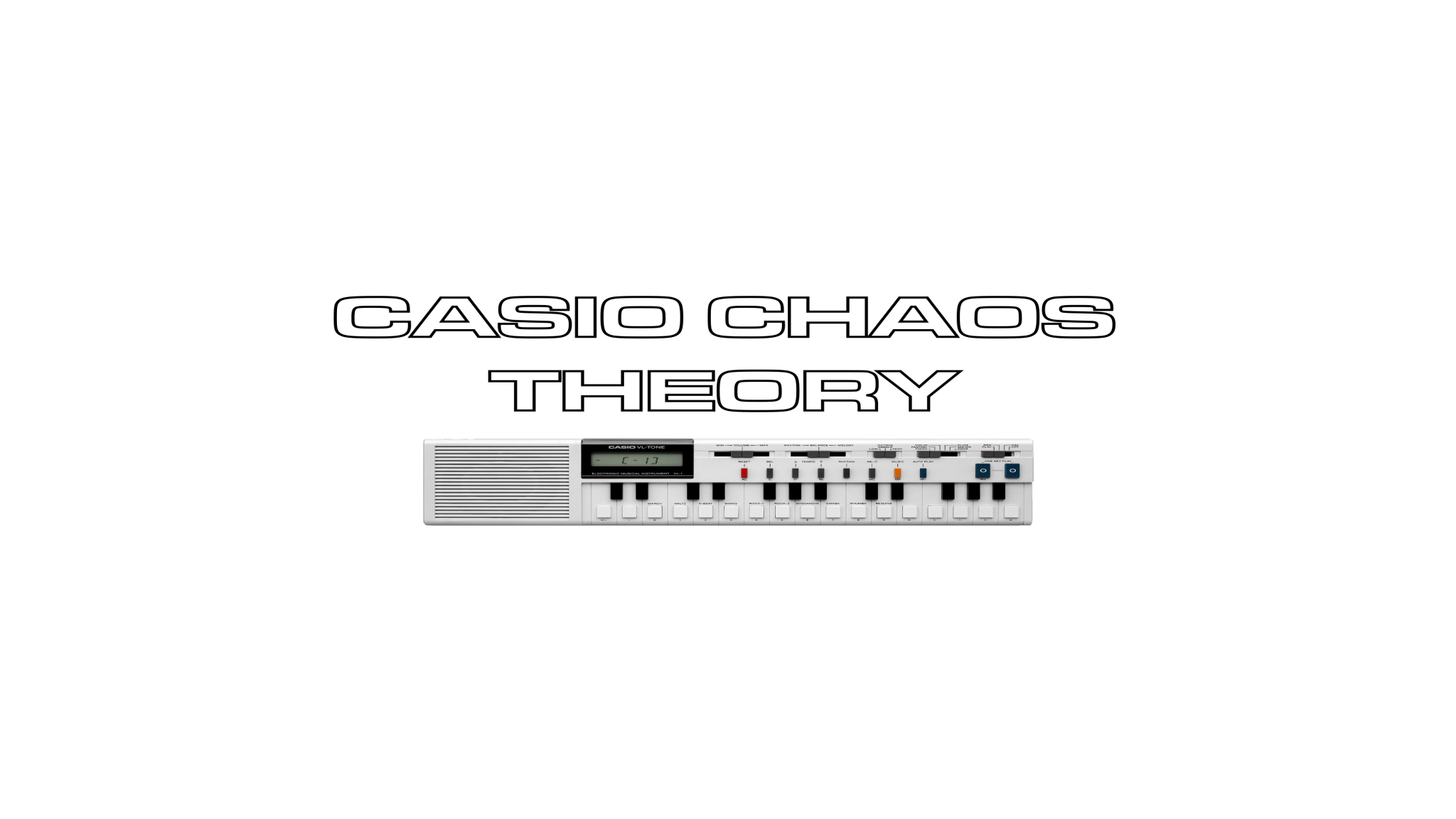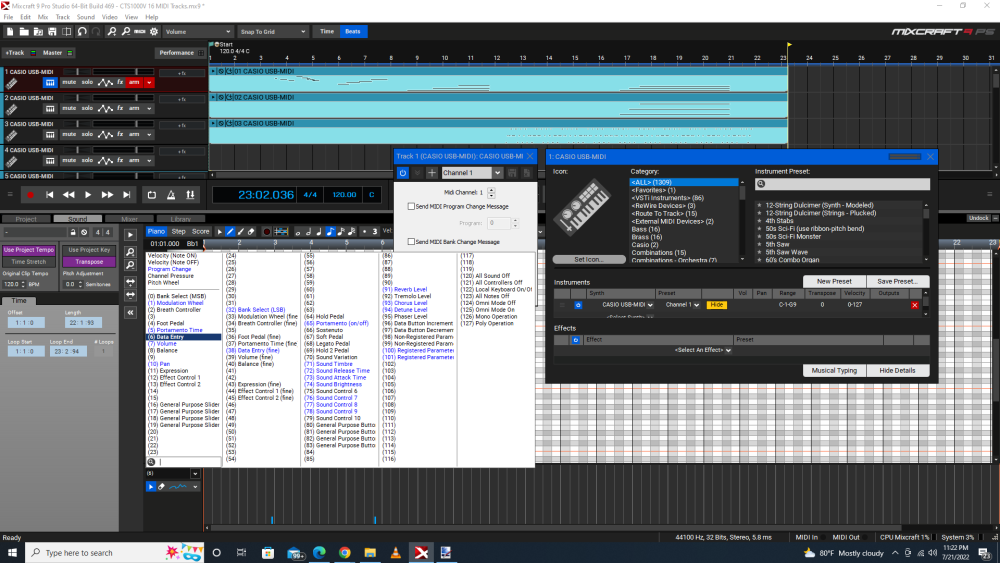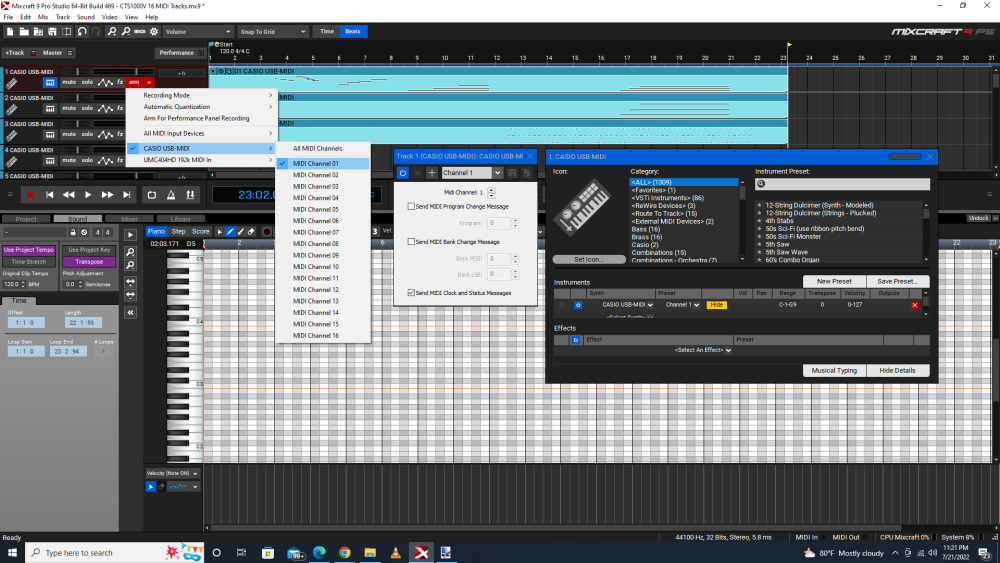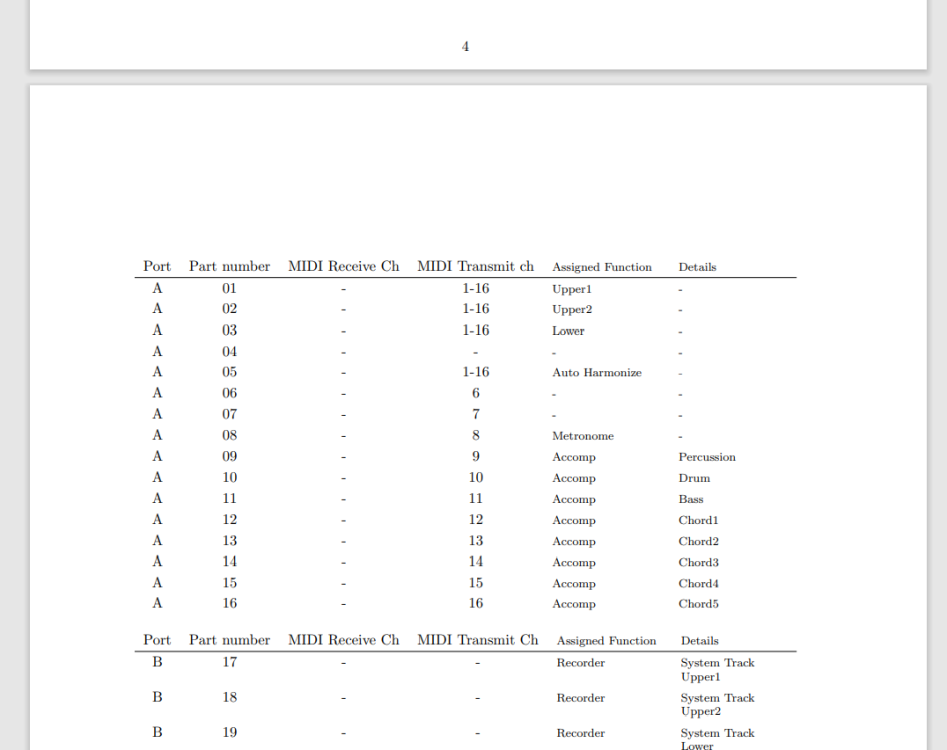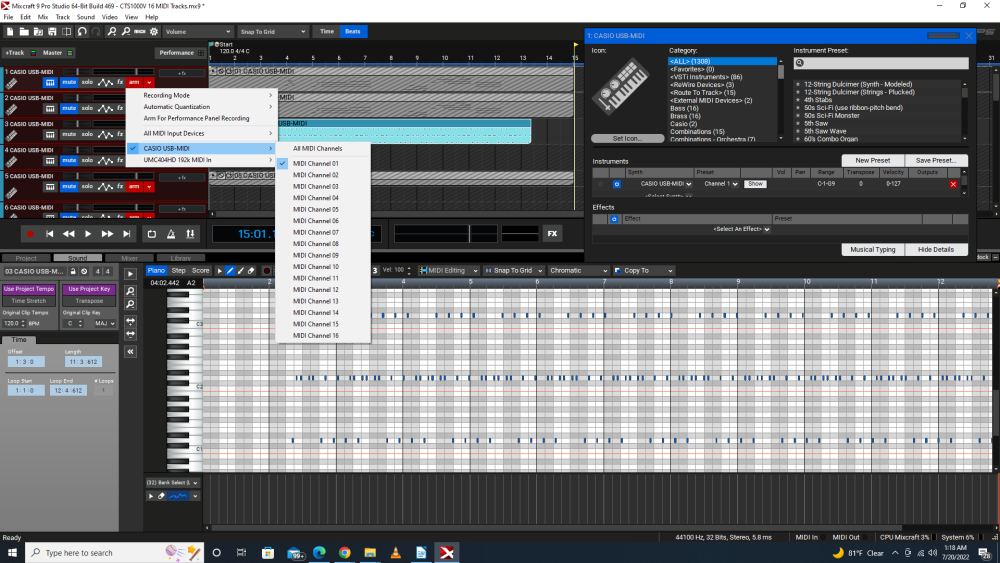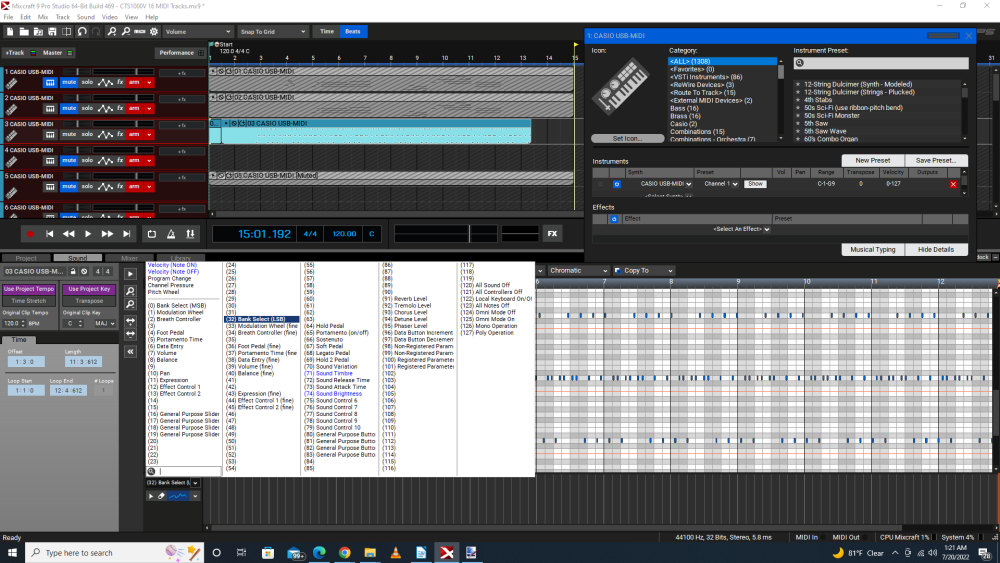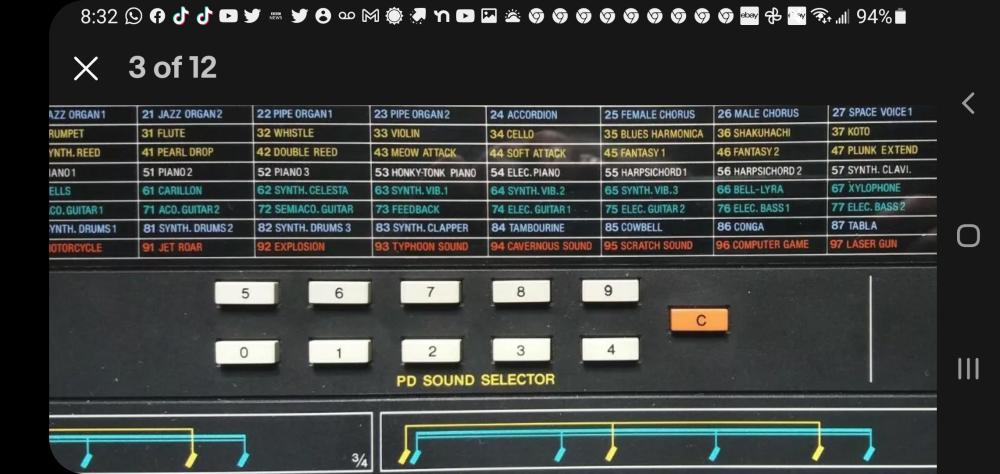-
Posts
1,041 -
Joined
-
Last visited
Content Type
Profiles
Forums
Downloads
Everything posted by Chas
-
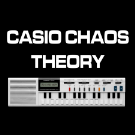
CT-S1000V Review Part 7 - MIDI Connectivity
Chas replied to Chas's topic in General CT-S1000V and CT-S500 Discussion
Thanks as always Brad for the heads up and suggestions. I've been doing some more experimenting with this and have been having quite a few hair pulling/ banging head on desk sessions! In one session of frustration, I thought "DAMN IT!" and for the hell of it I fired up a different DAW (Reaper) just to rule out my DAW (Mixcraft) being the issue. I have an evaluation copy of Reaper installed from when I was testing out DAWs, but decided to go with Mixcraft because I preferred the layout and workflow better. Anyhow, though I don't know my way around Reaper anywhere near as well as Mixcraft, I managed to set up a MIDI recording project and recorded the S1000V's MIDI. During recording I selected a registration I had made that used a split keyboard and arpeggiator, toggled between "Instrument" and "Lyrics", and also hit the layer button to layer a U2 TONE with a U1 Tone. Reaper recorded all of this, and also played it back correctly. The way it routes recorded MIDI tracks is different to Mixcraft and I'm not sure if that's what is the issue. I should also mention that a couple of times it didn't record the "lyrics"/ Vocal Synthesis selection properly and played that back with a different sound. Mostly though, it seemed to do correctly what Mixcraft doesn't. This all seems to suggest that part of my MIDI recording issue is with Mixcraft, not so much the S1000V or my audio/ MIDI interface. And that the issue seems to be with MIDI playback and not the actual MIDI recording. Here's my dilemma though. I've invested considerable time and also money into Mixcraft, so I really don't want to have to switch DAWs. Plus I have numerous projects on the go as well as a whole bunch of templates. Switching to another DAW at this stage would be frustrating and time consuming, therefore I'd like to try and get to the bottom of why Mixcraft is not sending recorded MIDI back out to the S1000V correctly. My DAW (Mixcraft Pro Studio 9) doesn't have a MIDI events viewer like the one in your picture, but it does show all CC changes made in an automation lane. I can select from a list any individual CC parameter, then any changes will be shown as blue vertical lines along the time line. Each line represents a value from 0 - 127, and can also be edited (or drawn in) to change the value by increasing or decreasing the line height. In the picture below you can see highlighted in blue all active MIDI CC parameters used on the selected track, and you can also see that I've selected the Data Entry parameter (6) that shows two places along the time line where changes were made. I've also checked the values of the Program Change, Bank Select (MSB) and Bank Select (LSB) recorded entries and their values correspond to Tone I selected with the Tone list in the User Guide. Therefore I can confirm that yes, my DAW is recording all these MIDI CC changes correctly., but it's not sending them back out to the S1000V correctly. You can also see three track recordings in the picture above corresponding to Tone U1 (Track 1), Tone U2 (Track 2) and Tone L1 (Track 3). In the picture below you can see how I've routed the MIDI input and MIDI output of track no 1. Under the red "arm" button you can see the drop down boxes where I've selected incoming MIDI to come from Casio USB MIDI, and I've selected it to record the Casio USB MIDI Channel 01. The two windows in the middle and to the right show the output routing for Track 01, and you can again see that I've selected Casio USB and MIDI Channel 1. Note that during recording I switch off the MIDI output otherwise I would get MIDI loopback. Once the MIDI is recorded, then I switch it on. And FWIW, I've also experimented with routing a MIDI input track as "All MIDI Channels" rather than a specific number, and also checking/ unchecking the "Send MIDI clock and Status Messages" check box but get the same result One thing that confuses me though is page 5 of the MIDI USER Guide (see below). For parts 01 to 05, it states that each of these parts transmits on channels 1 - 16, whereas parts 06 to 16 transmit on single corresponding channels i..e. Part 06 only transmits on Channel 6. Also the MIDI receive channel for all part numbers is just shown as blank. From what I've shown above, is there anything standing out that might be what is causing me playback issues? Am I routing tracks correctly? For Parts 01 to 05, should I record them in and send them out as individual MIDI channels or should I select "All MIDI Channels"? I'm pretty sure that I've tried every possible combination but have had no luck. I'm really trying to get my head round this to resolve the issue so that I can make a follow up video to add to my CT-S1000V review series. Hopefully it's just a setting I've missed in Mixcraft rather than a bug that requires me to switch to another DAW! -

CT-S1000V Review Part 7 - MIDI Connectivity
Chas replied to Chas's topic in General CT-S1000V and CT-S500 Discussion
Hey all, after house sitting an elderly relative and then having another family relative come to stay with us for a week, I'm back to trying to get this MIDI recording and layering aspect of the S1000V functioning in my DAW so I can make a follow up video. @Brad Saucier- I've tried some of your suggestions to get my DAW to record bank/ program changes, and also Registrations, AFTER I hit record, but I'm not having a lot of luck. I don't know if it's my DAW or some setting I'm missing. I'm still having the same issue of my DAW recording the MIDI note data fine, but it reverts back back to the same default sounds as per when I imported a previously recorded S1000V MIDI file in the Recording Episode of my review series, even though each track has been routed to the appropriate Casio MIDI channel. I've set my DAW project up as per below. Each Recording MIDI track, 1 to 16, is armed to correspond with the 16 tracks available via the Casio USB MIDI input (the drop down boxes on the left of the screen). The output "Instrument" for each track is routed to the same MIDI track/ channel number using the Casio USB external device. (the window to the right of the screen) I toggle the output device to mute when a track is armed and recording, and then do the reverse when when I want to play the recorded track back (unarm the track and unmute the external Casio "instrument"). As said, it will record the three MIDI parts of the S1000V, such as U1 and U2 upper Tone layers (U2 if engaged) and also an L1 split Tone (if lower split is engaged). But, it won't record the Program or Registration changes and will only play back using the same default sounds. However, I guess a work around is to go into the automation section of each MIDI track, and there I found all the MIDI parameters that can be automated/ changed. I can then set Program, MSB, and LSB at the very beginning to engage the correct Tone on playback, plus I can also change any of the other CC parameters at any point. This also means that I can draw in and automate the Filter cut-off CC parameter to replicate an LFO and/ or envelope that the S1000V lacks. By setting MIDI CC parameters at the beginning of each automation track, I am able to simultaneously play multiple Tone layers in the S1000V via MIDI, as well as replicate an LFO sweeping the filter cut off. It is still a crying shame that the ACT DSPs cannot be used over MIDI, and of course it would have been nice for my DAW to be able to record my S1000V in the state it was currently set rather than have to enter a number of MIDI CC details, but at least it seems to be a workaround. Any idea why my DAW isn't recording the Program and Bank changes at the start of the track? Is there a MIDI setting that I've missed somewhere? -

CT-S1000V Review Part 8 - BLUETOOTH Connectivity
Chas replied to Chas's topic in General CT-S1000V and CT-S500 Discussion
Good points Brad, and thanks also for pointing out that Bluetooth MIDI would be less susceptible to latency as it's not transferring anywhere near the amount of data required compared with streaming audio.. In my "studio" my main workstation DAW computer does not have Bluetooth, hence for me Bluetooth capability serves no purpose. Plus I am still oldschool and come from the era of recording studios where EVERYTHING was wired, and wireless mics and guitar transmitters were banned because of the risk of interference, as well as issues with sound quality loses. Even cellphones weren't allowed in the control room or near any audio equipment! Things may have changed since then (early 2010s), but I still adhere to the cables only rule when it comes to recording, plus as mentioned, I couldn't use Bluetooth with my main desktop even if I wanted to. Regarding sampling, yes, I finally figured out that you can sample AUDIO over Bluetooth, not transfer a WAV file as I originally thought. However, my main issue with sampling audio directly in to the S1000V was the absence of onboard sample editing ability, along with only being able to save the captured sample in a proprietary file format. I often reuse samples in other projects, and also modify and experiment with them by using audio editing tools., plus I also share samples with other musicians. I wouldn't be able to do any of this if I sampled audio directly into the S1000V because of the proprietary sample file format. Hence my recommendation of capturing and editing samples elsewhere, and then importing them into the Casiotone as a WAV file. If the sample was captured and modified by a cellphone/ tablet first and then transferred via Bluetooth, then that would make more sense. But as I do all my sample editing with my Desktop PC, it's just as easy to copy the modified sample file to a flash drive and simply import it into the S1000V as a WAV file. As I've mentioned during my reviews, much of how I perceive the keyboard (any keyboard in fact) is based entirely on my own perspective, experience and how I try to use it within my normal workflow. I'm just an average Joe that likely represents a similar experience that many others approaching the using of the S1000V in similar home studios would have. -

CT-S1000V Review Part 7 - MIDI Connectivity
Chas replied to Chas's topic in General CT-S1000V and CT-S500 Discussion
@Brad Saucier - Many thanks as always for clarifying and expanding on the technicalities of this quirky beast! I should have been clearer in my review when I said that you couldn't layer Tones over MIDI, because what I meant was that you couldn't activate the "Layer" function as per the UI. I did mention that the S1000V was 48 part multi timbral, so yes, you can layer by the use of separate MIDI tracks but my point was that it would have been nice to have been able to record one MIDI track and have it play the two layered Tones as already set up in a Registration. Also yes, you can add the required Tone to a MIDI track by selecting it after pressing record, though by using the pop up box and adding the bank and program change number beforehand does the same thing, at least in my DAW. And that's how all my other MIDI devices generally operate. It would be kind of awkward if a MIDI part came in right at the beginning of a track and I'm trying to select it while recording has already started! The process I've always worked with is to arm the appropriate MIDI track with all the details, such as patch number and MIDI channel before the record button is hit. Regarding recording a Registration with splits and layers via multiple MIDI tracks, thank you for the heads up on that one. I will try that once I am back home (we've been away for over a week and a half house sitting an elderly relative). We return home this weekend, and though I'm going to have a lot of catching up to do (I'm dreading the state of the yard and the pool!) I'm planning on resuming filming and editing my various projects asap. With this new information (thank you again) I will look at putting together an addendum MIDI Connectivity video to cover the MIDI information that you have just given to me. It's also worth pointing out that I HAVE spent of lot of time trying to understand the S1000V, including pouring over the main User Guide and also the MIDI user guide, and was trying to go by the information I read. And as much as I haasve encouraged people to NOT approach the S1000V from the mindset and workflow of a pure synth, maybe I was guilty of doing just that. And though I am no expert, I perhaps have a little more experience and knowledge that the general buyers of the S1000V won't have, thus it's likely that I won't be the only person to find themselves in this situation. In fact in some discussions I've seen had the exact same thing happening, including one buyer returning it because he couldn't get the MIDI to record the Tones as in the current state his keyboard was in. A constructive suggestion if this might well be a regular occurrence when people are trying to record splits and layers as MIDI within a DAW - perhaps for the next revision of the User Guide/ MIDI User Guide is to include a section explaining how to do exactly this. Because users used to a "pure" synth expect that generally it outputs just one MIDI track with all parameters set beforehand, and this will be recorded as a single track MIDI recording. Whereas with the Casiotone having so many different sections, a lot of users aren't familiar with setting up multiple MIDI tracks to record all the different sections simultaneously. Anyway, thanks once again for the helpful information and advice, and I will be sure to try this out when I'm back home. -

CT-S1000V Review Part 7 - MIDI Connectivity
Chas replied to Chas's topic in General CT-S1000V and CT-S500 Discussion
Thank you! Fellow Brit here also (you could probably tell by my accent in my videos!) Originally from Watford/ NW London, now leaving in West Central Florida! -
All the Casiotone models are preset keyboards and none of them can save "Tones". One problem that many have coming to them from more synth based keyboards is getting their heads around not being able to save modified presets as "Tones" or patches. Or expecting the Casiotones to behave in the way a more conventional synth does. The more powerful Casiotones approach the saving of modified tones as Registrations in the same way that a programmable organ does. It's the exact same principle - select a pure preset Tone, add/ adjust/ modify all the modulations you want to use with it, then save as a Registration for recall later. I'm sure you know that the Leslie Speaker is an addition, and not all organs had or used them. So you have the option to add a Leslie speaker DSP to an organ Tone if you wish, but not all preset organ Tones need it and not all users want to use it. It's up to you to add it if you want. I agree with you that not being able to name registrations is a strange omission and makes recalling them harder, however, once you start working with them it's not too hard to remember the banks and numbers of your saved custom sounds. It's what church organists have had to do for many years. And though you have a point that maybe the Leslie effect could have been the default TONE DSP for some of the organ patches, do remember that CMF is an independent user generated and run forum, not the official forum for the Casio company. Perhaps getting the point across in a friendlier manner may help raise your issue more positively. Brad contributes to CMF voluntarily, as I and others do also, and he is here trying to offer you a solution not to take the flak for design decisions/ choices that have nothing to do with him. Maybe instead ask to have a pinned topic of "S1000V/ S500 Firmware Upgrade Suggestions" that users would like to see implemented and can add to, such as including the Leslie DSP to (XYZ) Organ Tones?
-
@Lechdude - I agree with all that you said. There may be reasons for this nerfing of some features, though I can't for the life of me fathom what they are. I do understand that with so many sections and features in the S1000V some compromises have to be made. BUT, with the Tones and DSPs being some of the major selling points of this keyboard, why on earth cripple them when using MIDI? If a "pure" synth had done this it would be absolutely roasted and rightly so. There are of course workarounds and it can still be used with a DAW, but it will lose interest from the more synth type players who don't want to faff around with MIDI limitations. It is a shame as otherwise the S1000V is so close to being an all time classic with a wide appeal, but this feature omission knocks it down a place or two. As I've mentioned numerous times, it's still a great keyboard and good value for what it offers, but if only that last 10% of its features had been addressed... Anyhow, part 7 of my review is now up where I cover the use of MIDI along with the limitations!
-

Can a Privia-PX 76 Connect To A Focusrite?
Chas replied to 38magterri's topic in General Casio Discussion
As Joe says above, most keyboards transmit audio via their line outs, not USB. You'll need to connect the PX line outs (most likely 1/4"/ 6.5mm TR jacks to your Focusrite interface. You didn't say which model Focusrite interface you have, as the most basic sound interface models sometimes come with just one or two inputs. If you want to record the audio of your PX simultaneously with a mic line in, you will need a minimum of two line inputs (the PX will have to be recorded in mono if you only have two). Or if you want to record the PX as stereo with your mic input you will need to have an interface that can handle three inputs at once (most likely a four input interface model). -
Lechefdude, Many thanks for your question both here and also on my YouTube "Vocal Synthesis" video, and also for bringing this MIDI restriction issue to my attention. I've made it very clear in my already published episodes that I love this quirky and unusual keyboard and was happy to accept its quirks and idiosyncrasies, though finding out about this MIDI restriction I admit surprised me. Especially after exploring the use of DSPs and layering to create some epic tones only to now find that they cannot be triggered over MIDI. It seems a very strange feature omission, and I'm not sure how/ why this would get signed off by the R&D and design departments at Casio. Obviously it won't affect owners who play everything live from the keyboard, but for electronic/ EDM music and DAW based MIDI artists, this is going to be quite off putting. We can but hope for a major firmware update to address this. And yes you are correct, the System Effects are available and controllable over MIDI, and also the Vocal Synthesis (very thankfully). As mentioned in my YouTube reply, it's still a great keyboard even with this MIDI restriction, but I strongly believe that it would appeal to a greater user base if the MIDI implementation was improved so that the S1000V can utilise its DSPs and Layering over MIDI as well.
-
Hey all, Here's Part 6 of my CT-S1000V review where I dive into the recording feature and demonstrate how to use it to make a quick recording, how to build up a multitrack recording, and also discovering some idiosyncrasies when it comes to exporting and importing files in the MIDI file format. Enjoy!
- 1 reply
-
- 3
-

-
Impressive work, nice job! Even more impressive considering that for the original recording, Harold Faltermeyer used a bunch of high end synths - Moog Modular = bass, Roland Jupiter 8 = lead, Yamaha DX7 = bells & marimba, Roland JX-3P = stabs. And you did it entirely with a "home keyboard" released barely 3 years after the original recording! Plus I've always loved Axel F, a great synthpop song.
-
A quick Google search and I found a couple of sellers with new LA4120 chips for sale: https://www.ecrater.com/p/29112806/sanyo-la4120-2-channel-af-power https://www.ebay.com/itm/371237825471?mkcid=16&mkevt=1&mkrid=711-127632-2357-0&ssspo=PkjcM4faSgC&sssrc=2349624&ssuid=Y2Gbk031Qm2&var=&widget_ver=artemis&media=COPY
-
This has kind of got me stumped while using my DAW, and recording/ sending MIDI to and from the S1000V. I can record a MIDI track from my S1000V no problem. However, I want to play this MIDI track from my DAW back into the S1000V and have it play a Tone with ACT DSPs applied to it. I can't for the life work out how to do this, as whatever I try just plays back the Tone without any ACT DSPs applied. Is it not possible for the S1000V to receive and play MIDI and also use its ACT DSPs? I've looked at Page 353 of the User Guide and can't find anything relating to ACT DSPs or Registrations in the Control Change section, nor can I find anything specific in the MIDI Implementation Guide. Also, is there anyway I can just have the S1000V independently set up with a Registration or selected TONE, and then have it receive and play just MIDI notes from a DAW without any Control or Program changes occurring? i.e. Whatever Tone is currently selected on the S1000V itself, if I send MIDI note data to it from my DAW it will play that same Tone and not change it to something else? Also, the specifications state that the S1000V is multi-timbral with 64 notes of polyphony, but it doesn't state how many parts multi-timbral it is. I'm assuming it's multi-timbral as in 2 x Upper Layers, 1 x Lower layer and 1 x Rhythm (Drum)? It's a fun keyboard without a doubt, but damn it is quirky!
-
No floppy drive in the VZ series, only an RC RAM/ ROM card slot. The FZ series did use a floppy drive, with the FZ-20M being equipped with a SCSI connector/ interface.
-
Hey all, Here's Part 5 of my CT-S1000V review where I take a deep look at the sampling feature. And as the S1000V's Tone No. 545, the Classic Casio "E. Piano" is based on a vintage Casiotone I of course had to sample my own 1980 CT-201 into the S1000V to compare the two tones! And though the S1000V's Sampler feature is a little limited as far as actual sampling is concerned, by using all the other S1000V features you can really transform the samples and take them into very different sonic places. Enjoy!
- 1 reply
-
- 2
-

-
If you haven't already seen it, check out my video where I covered the vocal synthesis section of the S1000V. It shows how easy it should be to connect a phone to the Casiotone and also to download/ use the app. Though I was using an Android phone, the principles should also apply to iOS devices. And FWIW, my phone (S10) connected fine using an old Galaxy S2 USB phone cable, and also a generic modern USB 2.0 to USB micro B cable, and both with a cheap adapter (USB 2.0 to USB C).
-
"Bit Rot" is an unfortunately not an uncommon occurrence, often happening as a result of old age and/ or voltage spikes. Some chips are notorious for this, for instance some of the custom chips in the Commodore 64 computer are well known to fail causing all sorts of issues. IIRC, the SID sound chip and also the PLA chip used for the display can often go bad. Luckily some chips are being reproduced or even emulated via FPGA means, though some custom chip firmware is still under copyright causing legal issues. Another example is the chip (actually a resistor pack) used as part of the tachometer circuit in many 1980s GM vehicles. One of the resistors inside the chip goes bad with age (all the others continue to work fine) leading to an over reading or non functioning tachometer. My own 86 Monte Carlo has this issue, and luckily it can be rectified by cutting the legs of the chip where the bad resistor connects, and soldering in place a conventional resistor of the correct value. It's not pretty but it's hidden away from sight and solves the issue. More of a concern are modern devices where it's impossible to read the LSI chips without proprietary software readers. That and the fact that many are so complex, it would be a massive task to read and reproduce the firmware used on them, plus the nightmare of trying to physically swap out a modern SMD LSI chip. Even some of my early 80s Casios use tiny SMD LSIs that are beyond my ability, to swap out though luckily Casios generally tend to be very reliable. I've only ever had two failures - a RIFA Capacitor (aka RIFA Bombs) in my CT403 self destructed in a most spectacular fashion (I never knew so much smoke can come from such a tiny component), and one of my HT6000s went dead on me while playing it. The CT403 was easy to sort by replacing the RIFA Capacitor with a better quality replacement and it was up and running again. My HT6000 though was not so easy. I took it apart to see if anything was obvious but my electronics skills are rather rudimentary and I couldn't spot anything obviously amiss. I found that the power board had voltage and appeared to be sending it to the main board, but that was as far as my skills go. As I have two other HT6000s that work I put the dead 6000 back together to be sorted at a time when I have the required skills and knowledge.
-
Using the XW's arpeggiator should get you close to the retriggered note sound that you are after. However, I don't think the XW has a polyphonic arpeggiator, and the sound you are hearing in that Rush song sounds more like a staccato chord. In that case, maybe using the Phrase Sequencer might get you closer?
-
I'm going by what I've read so take it with a pinch of salt. However, to answer your questions: IIRC, the CZ230S has 100 slots, of which 96 are factory preset only and the last 4 can have user patches. But those last 4 can only be programmed via SYSEX over MIDI - there is no way to program patches via the 230S's front panel. As for selecting patches, unlike the other CZs that use banks and numbers, the 230S just uses a number pad from 0 to 9 (see pic). If you can download the user guide from somewhere you should be able to double check and confirm the above. Hope this helps!
- 49 replies
-
- 1
-

-
- replacement key
- casio
-
(and 1 more)
Tagged with:
-

Problem Playing Ct-S500 From Another Keyboard
Chas replied to BenWaB3's topic in General CT-S1000V and CT-S500 Discussion
This is standard behavior for USB MIDI - a host is always required. You cannot directly connect two keyboards with just a USB MIDI cable and trigger one from the other the way you can with 5 pin DIN MIDI. The way round this is to get something like a USB MIDI host box/ converter. https://www.amazon.com/CAMOLA-MIDI-Host-Interface-Converter/dp/B08MZY59B7/ref=asc_df_B08MZY59B7/?tag=hyprod-20&linkCode=df0&hvadid=475739771007&hvpos=&hvnetw=g&hvrand=13038967399193424064&hvpone=&hvptwo=&hvqmt=&hvdev=m&hvdvcmdl=&hvlocint=&hvlocphy=9012036&hvtargid=pla-1279159642272&psc=1 -

Problems connecting to CT-S1000V
Chas replied to cwolin's topic in General CT-S1000V and CT-S500 Discussion
@13.20 onward in my video I show all the steps and how easy it is to connect the S1000V to a cellphone, and to download/ install/ use the Lyric Creator APP. The information is for Android, but it might be similar and help guide you with iOS.

